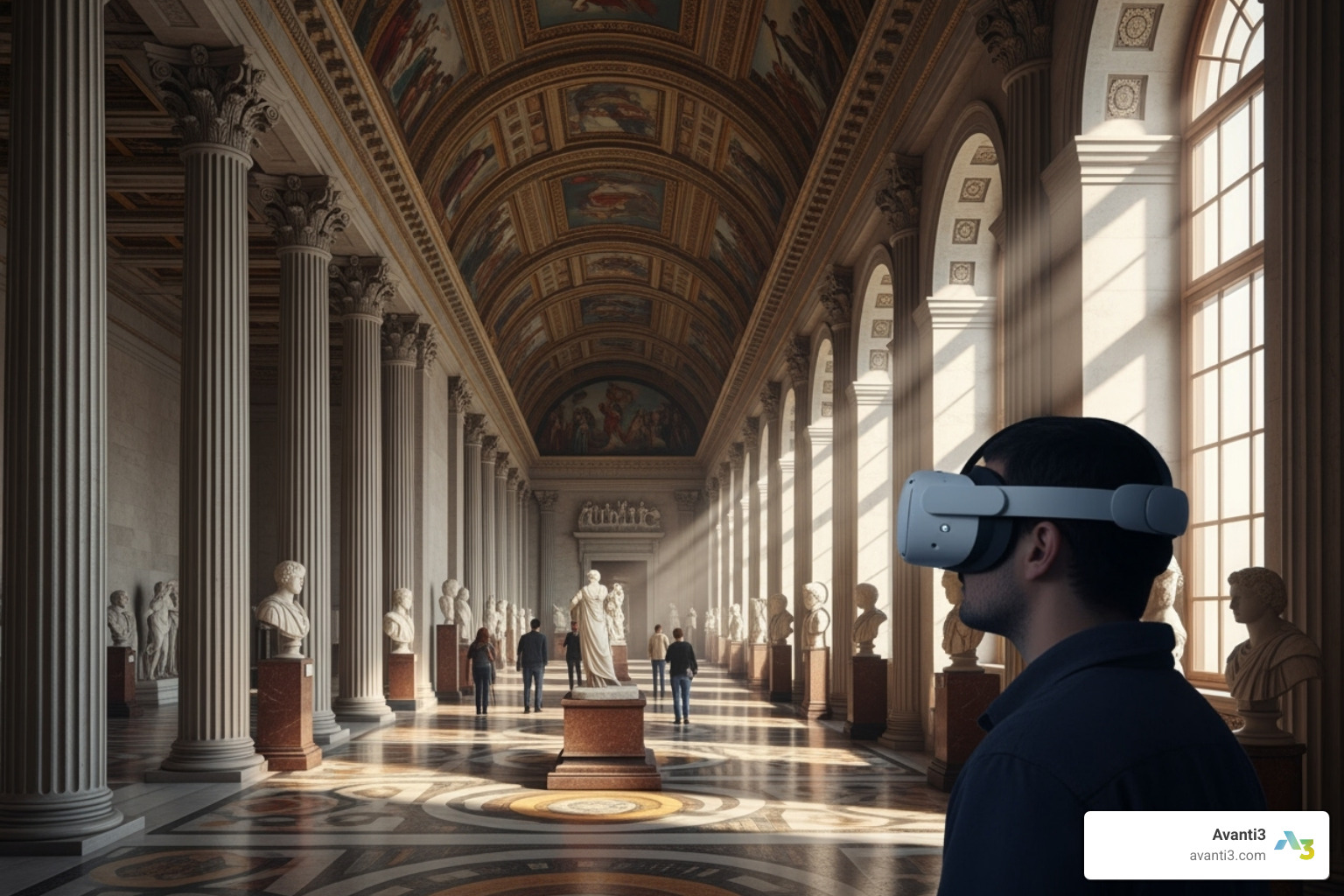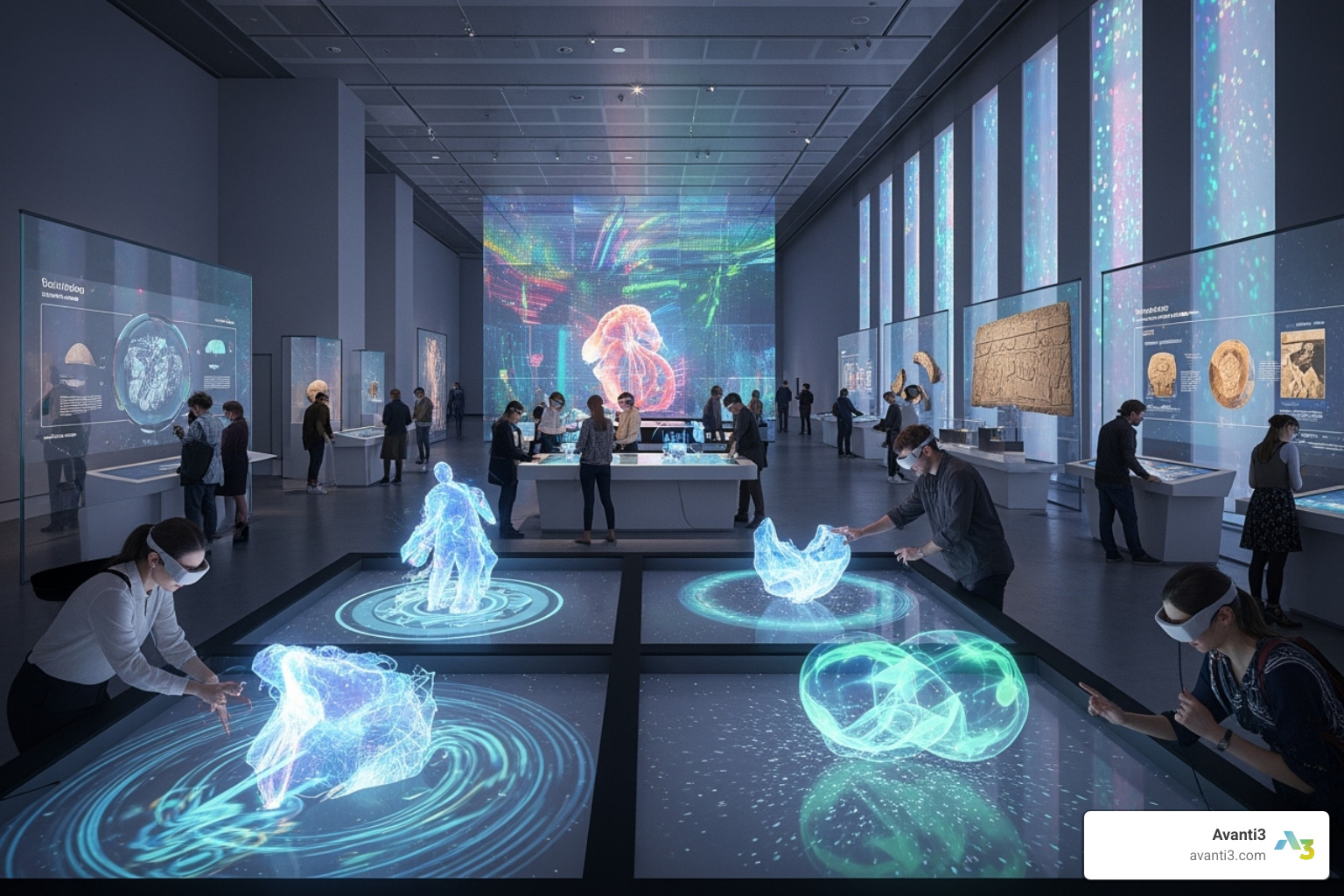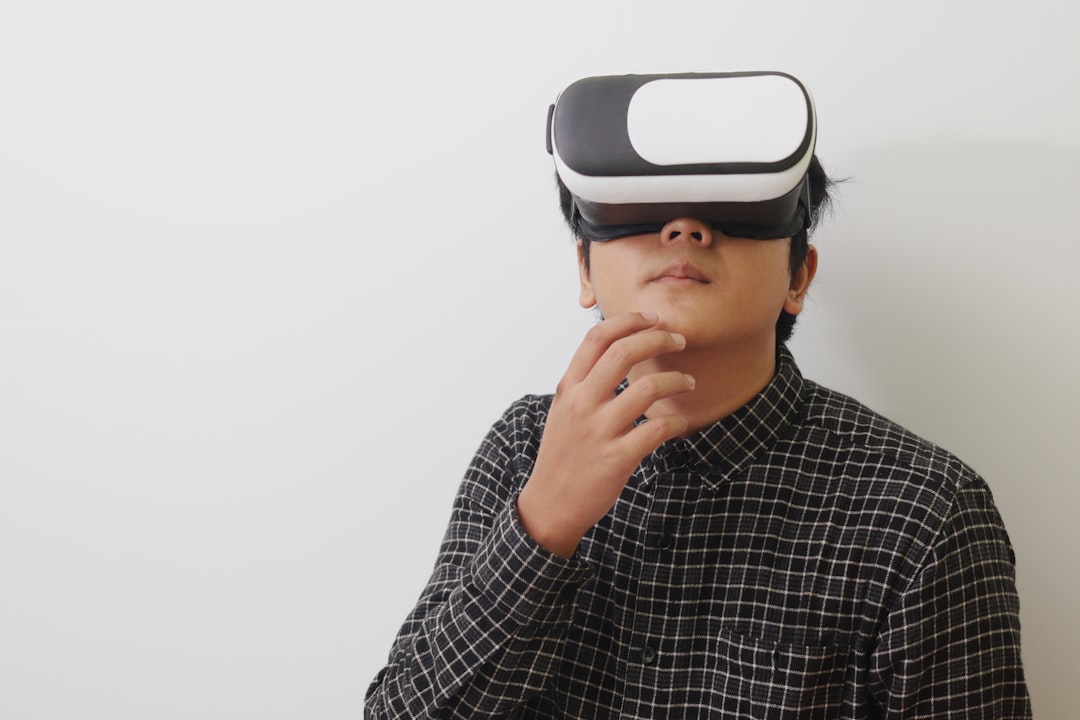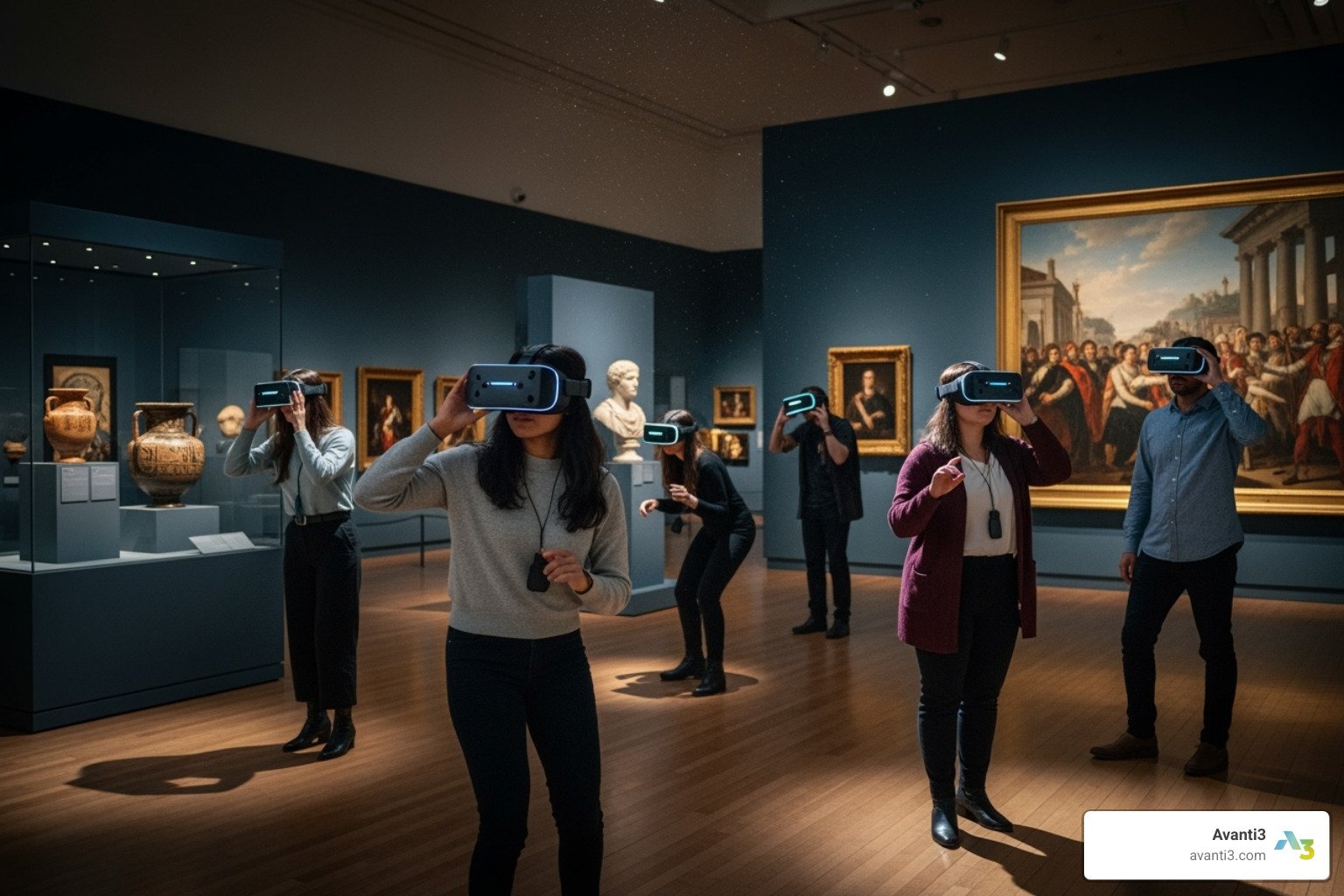Virtual reality tours of museums 2025: Immersive!
A New Dimension for Art and History
Virtual reality tours of museums are changing how we experience art and culture. These immersive experiences transport you to world-class institutions like the Louvre, the Vatican Museums, or the British Museum without leaving home. VR technology eliminates physical barriers like distance, crowds, and accessibility issues, opening doors for everyone.
Some of the top museum VR tours are available through platforms like Google Arts & Culture, which partners with over 2,000 institutions, including:
- The Louvre: “Mona Lisa: Beyond the Glass”
- Vatican Museums: The Sistine Chapel
- British Museum: Ancient artifacts like the Rosetta Stone
- Van Gogh Museum: Masterpieces and artistic techniques
Unlike traditional visits, VR tours offer unparalleled interactivity. Imagine examining the texture of Van Gogh’s brushstrokes up close or walking through a recreated Renaissance artist’s studio. Museums are using VR to preserve temporary exhibitions and showcase objects at their true scale, changing passive viewing into active exploration.
I’m Samir ElKamouny AV, and through my work with immersive technologies, I’ve seen how virtual reality tours of museums create meaningful connections between audiences and content.
Learn more about virtual reality tours of museums:
So, what is virtual reality (VR)? It’s a technology that creates simulated 3D environments, making you feel like you’re truly there. For museums, this means moving beyond static displays to offer dynamic, interactive narratives that deepen visitors’ understanding. It’s about shifting the experience from watching to doing.
Traditional Museum Visit vs. Virtual Reality Tour: A Comparative Look
- Physical Presence:
- Traditional: Requires travel to a physical location with set hours.
- VR Tour: Accessible 24/7 from anywhere with an internet connection.
- Accessibility:
- Traditional: Can be difficult for those with mobility issues or limited travel budgets.
- VR Tour: Highly accessible to a global audience, including people with physical limitations.
- Immersion & Interaction:
- Traditional: Interaction is limited; artifacts are behind glass.
- VR Tour: Deep immersion with interactive digital models and recreated historical spaces.
- Crowds & Pace:
- Traditional: Often crowded, with a pace dictated by museum flow.
- VR Tour: A personal experience with no crowds or lines, explored at your own pace.
As we dig deeper, we’ll see how virtual reality tours of museums are not just a novelty but a powerful tool for Digital Experience Design, offering new ways to connect with our shared cultural heritage.
The Best Virtual Reality Tours of Museums You Can Experience Today
The museum world has acceptd VR, creating experiences that redefine what it means to visit a museum. These aren’t just digital copies; they’re entirely new ways to connect with art, history, and culture.
Step Inside the Masterpiece
What if you could walk into a Van Gogh painting? VR makes this possible, turning art viewing into a lived experience.
- Musée d’Orsay’s “Van Gogh’s Palette” let visitors explore the artist’s creative world from the inside out.
- The Louvre’s “Mona Lisa: Beyond the Glass” allows you to see details of the famous painting invisible to the naked eye.
- Tate Modern has recreated artist studios, while the Kremer Museum exists entirely in VR, showcasing old masters in a unique virtual space.
These experiences create a deep, personal connection with the art and artist, which is the goal of well-designed Virtual Reality Experiences.
Walk Through World-Famous Halls

VR tours let you appreciate magnificent museum architecture and collections at your own pace, free from crowds.
- Google Arts & Culture provides access to over 2,000 museums, allowing you to virtually visit The Met in New York, the Rijksmuseum in Amsterdam, and the Uffizi Gallery in Florence in a single day.
- The Met’s 360° Project captures the grandeur of its halls, including The Met Cloisters, without any crowds.
- The Vatican Museums offer private, unhurried viewings of the Sistine Chapel.
- The Canadian Museum of History allows exploration of its stunning architecture and vast collections without the rush of a physical visit.
These virtual tour experiences empower you to explore on your own terms, making for a richer, more personal journey.
Explore Unique and Niche Collections
VR provides access to collections that are temporary, under renovation, or in remote locations.
- The Pergamon Museum in Berlin is closed for renovation, but its VR tour keeps the Ishtar Gate and other treasures accessible.
- The Smithsonian’s “No Spectators: The Art of Burning Man” exhibition is preserved in VR, capturing a temporary cultural event.
- The Frida Kahlo Museum offers an intimate, private tour of her home, free from the usual crowds.
- The National Museum of Modern and Contemporary Art, Korea provides a rare behind-the-scenes look at its art storage facility.
These AR/VR Immersive Experiences offer access to otherwise impossible-to-see cultural treasures.
The Benefits of Immersive Virtual Reality Tours of Museums
The shift to virtual reality tours of museums offers fundamental benefits for both institutions and visitors:
- Global Access: Explore the world’s greatest collections from anywhere, anytime.
- Improved Accessibility: VR provides cultural equity, opening doors for people with mobility challenges.
- Improved Storytelling: See artifacts in their original historical context for a richer narrative.
- Engaging New Audiences: Meet younger generations on their turf with interactive technology.
- Digital Preservation: Ensure temporary exhibitions and fragile sites remain accessible for the future.
Thoughtfully implemented VR is a powerful tool for Digital Brand Engagement.
Challenges and Considerations for Virtual Reality Tours of Museums
Creating high-quality VR tours involves several challenges for museums:
- Development Costs: Building immersive experiences requires significant investment in specialized equipment and talent.
- Hardware and Maintenance: The cost of purchasing and maintaining VR headsets and computers can be high.
- Hygiene Concerns: Shared headsets require rigorous cleaning protocols to ensure visitor safety.
- Simulation Sickness: Some users may experience nausea, requiring careful design to minimize these effects.
- Avoiding Gimmicks: The biggest challenge is ensuring VR adds real value rather than being a superficial tech demo.
Despite these problems, careful planning allows museums to create transformative Digital Engagement Solutions that bring collections to life.
The Future of Digital Museums and Cultural Engagement

The future of virtual reality tours of museums is bright, promising a revolution in how we connect with culture.
Imagine exploring an ancient tomb with an AI-powered virtual docent answering your questions in real-time. Artificial Intelligence will personalize visits, curating tours based on your interests. Technology like advanced haptic feedback will let you “feel” the texture of a painting, while eye-tracking will adapt the experience to what captures your attention.
Web3 technologies are also opening new doors. Museums are exploring NFTs in art and blockchain to engage audiences and create new funding models. This fosters Digital Community Building, changing museums into vibrant global hubs where art lovers connect and share insights in shared virtual spaces.
At Avanti3, we integrate Web3, NFTs, blockchain, AR/VR, and AI to build these next-generation platforms. Our Digital Engagement Solutions don’t just showcase art—they build lasting connections between institutions and their audiences.
The future is a seamless blend of physical and digital experiences, each enhancing the other. As these worlds merge, they will create unprecedented opportunities for engagement. Find out how you can be part of this revolution with our custom virtual reality experiences.








